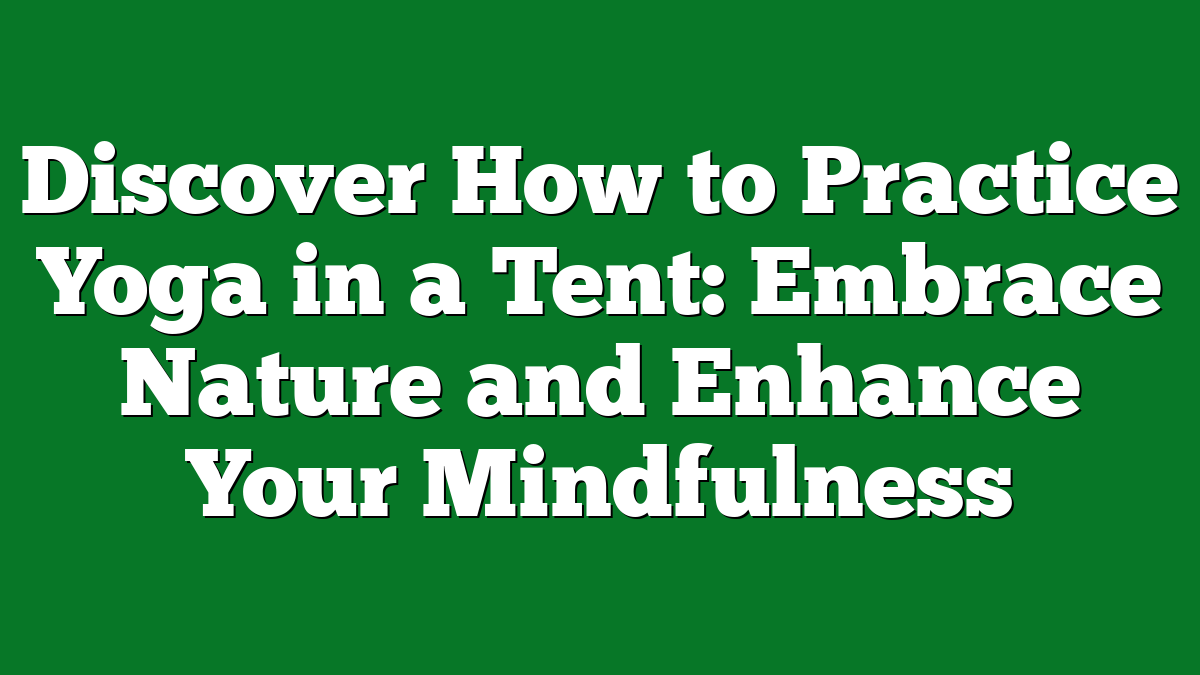Imagine unrolling your yoga mat surrounded by the sounds of nature, the gentle rustle of leaves, and the crisp morning air filling your lungs. Practicing yoga in a tent transforms your routine into a serene escape, blending mindfulness with the great outdoors. Whether you’re camping in the woods or enjoying a weekend getaway, this unique setting offers a refreshing twist to your practice.
Understanding the Benefits of Practicing Yoga in a Tent
Practicing yoga in a tent combines the tranquility of the outdoors with the clarity of mind that yoga encourages. This unique setting offers multiple benefits that enhance both the physical practice and the overall experience of being in nature.
Connection with Nature
Connecting with nature during yoga practice brings a sense of grounding. The gentle rustle of leaves, the distant sound of a flowing stream, and the fragrance of pine trees create a serene backdrop. Each breath becomes infused with the fresh, crisp air, deepening the connection to the earth beneath. Awareness of the natural surroundings enhances the practice, promoting a feeling of unity with the environment. Outdoor yoga fosters a deeper appreciation for the beauty and simplicity of the wild, reminding me of the joys of camping.
Enhanced Focus and Mindfulness
Practicing yoga in a tent heightens focus and mindfulness. The secluded setting reduces distractions that typically plague indoor environments. I find that the quiet sounds of nature allow my mind to clear, making it easier to focus on breath and movement. Each session nurtures a heightened sense of being present, promoting relaxation and mental clarity. With fewer interruptions, I achieve a meditative state more effortlessly. This enhanced mindfulness enriches the overall camping experience, allowing me to immerse completely in the enjoyment of nature and the moment.
Preparing Your Tent for Yoga
Preparing your tent for yoga sets the foundation for a peaceful session. Creating a comfortable and inviting environment makes a big difference in your practice, especially in nature.
Choosing the Right Tent Size
Choosing the right tent size is crucial for a successful yoga experience. I often use a two-person tent for my practice, as this size provides enough space for movement while still being cozy. Larger tents, like four-person models, offer extra space for mat placement and can accommodate small groups if friends join. When selecting a tent, ensure it has adequate height, allowing you to stretch your arms up without hitting the ceiling.
Setting Up Your Tent for Comfort
Setting up your tent for comfort enhances the overall experience. I usually start by placing my yoga mat on a clean, flat surface to avoid rocks or uneven ground. Adding insulation pads or blankets beneath my mat improves cushioning and makes poses like Downward Dog more enjoyable. I also position my tent to face beautiful views, so I can soak in the scenery during meditation. Keeping your space organized and clutter-free allows for a more focused practice, making it easier to connect with nature.
Yoga Practices to Try in a Tent
Practicing yoga in a tent can bring a unique and fulfilling experience. The confined space doesn’t limit the flow; it encourages creativity and mindfulness. Here are some yoga practices that work well in small, cozy setups.
Basic Yoga Poses for Limited Space
- Mountain Pose (Tadasana) – Stand tall with feet together. Engage your legs and lengthen your spine, feeling the grounding energy rise through you. This pose sets a solid foundation for any practice.
- Chair Pose (Utkatasana) – Bend your knees and lower your hips as if sitting in a chair. Raise your arms overhead, keeping your weight in your heels. This energizes the lower body while fitting easily within a small tent.
- Seated Forward Bend (Paschimottanasana) – Sit with legs extended and reach toward your toes. This deep stretch calms the mind and helps target tension from hiking or other outdoor activities.
- Cat-Cow Stretch (Marjaryasana-Bitilasana) – Transition between arching and rounding your back on all fours. This is excellent for warming up the spine in tight quarters.
- Child’s Pose (Balasana) – Kneel and fold forward, resting on your heels. This restorative pose requires minimal space and encourages relaxation in a plush environment.
Advanced Yoga Techniques for Experienced Yogis
- Crow Pose (Bakasana) – Balance your knees on your upper arms and tilt forward. This arm balance challenges strength and focus. I find that the confined space encourages a greater sense of control.
- King Pigeon Pose (Eka Pada Rajakapotasana) – From a forward bend, extend one leg back and arch your back while reaching for your foot. This pose demands space, yet can be modified carefully within the tent.
- Wheel Pose (Urdhva Dhanurasana) – Lie on your back, place your hands by your ears, and lift your body into a bridge. This powerful backbend expands chest and heart space, vital after days of camping.
- Half Moon Pose (Ardha Chandrasana) – Balance on one leg, extending the opposite leg and arm. This pose improves balance and focus, which can be enhanced through natural distractions outside.
- Savasana (Corpse Pose) – Lie flat on your back and relax every part of your body. In a tent, this becomes an immersive experience. Embrace the sounds of nature as you deeply relax and reflect.
The beauty of yoga in a tent lies in the adaptability; even within limited space, there’s a practice suitable for everyone. These techniques maintain a connection with nature while promoting physical and mental wellness, enriching my outdoor adventures.
Tips for a Successful Yoga Session in a Tent
Practicing yoga in a tent can transform your outdoor experience into a calming retreat. A few simple tips can enhance your session and deepen your connection to nature.
Creating a Calm Atmosphere
Creating a peaceful environment sets the tone for your yoga practice. I recommend using natural elements like stones or branches as props. Setting up your mat away from any clutter boosts tranquility. I also like incorporating soft lighting; a headlamp with a dim setting or a small lantern can create a soothing glow. When feasible, open the tent flaps to invite in fresh air and natural sounds, allowing the rustle of leaves or chirping birds to enhance your meditation.
Staying Safe and Comfortable
Staying comfortable and safe is crucial during your session. I always check the ground for sharp rocks or debris before laying out my mat. A thicker mat or additional cushioning can provide extra support, especially on uneven surfaces. Dressing in breathable, layered clothing helps regulate temperature during practice. If the weather turns chilly, I keep a lightweight blanket on hand for added warmth. Staying hydrated is essential, so I keep a water bottle nearby to sip throughout my routine.
Conclusion
Practicing yoga in a tent is such a unique way to connect with nature while nurturing my body and mind. The peaceful sounds and fresh air create an atmosphere that truly enhances my experience. Every session feels like a mini-retreat that helps me unwind and recharge.
I love how the simplicity of a tent encourages me to focus on my practice without distractions. It’s amazing how even the smallest space can feel so expansive when I’m fully present.
So whether I’m camping for a weekend or just escaping to the great outdoors, I’ll definitely keep rolling out my mat in my tent. It’s a delightful reminder that I can find peace and mindfulness anywhere, even in the middle of the wilderness.











